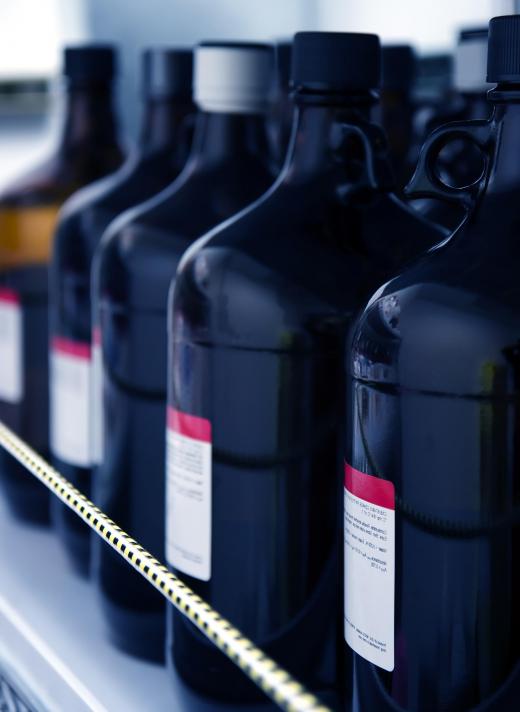What is Solvent Extraction?
 Mary McMahon
Mary McMahon
Solvent extraction is a method for separating a substance from one or more others by using a solvent. It relies on variations in the solubilities of different compounds in different substances. In most cases, the substance to be extracted, which may be a solid, a liquid or a gas, is dissolved in a liquid, along with other substances, and a liquid solvent is used for the extraction — this is sometimes called liquid-liquid extraction. The technique may also be applied to solid materials that contain compounds that need to be extracted. This method is widely used in industry, and in the laboratory for refining, isolating and purifying a variety of useful compounds.
Method

A solvent will be chosen that does not mix with the compound in which the substance of interest is currently dissolved, so that, when left undisturbed, they will form two separate layers, as with oil and water. It is also important that the compound to be extracted should have greater solubility in the solvent that has been added, and that this should not dissolve any unwanted substances in the original mixture. Once added, the two liquids may be shaken together for a time then allowed to stand for a while, so that they separate out. The choice of solvent to be used will depend on the chemical and physical properties of all the substances in the mixture. The process may need to be carried out in several stages, using different solvents.
Types of Solvent

There are two main types. In polar solvents, the molecules have a negative electrical charge at one end and a positive charge at the other. This is because one of the atoms tends to pull negatively charged electrons towards itself, leaving the rest of the molecule with a positive charge. Oxygen tends to do this, especially when bonded to hydrogen, so many liquids with oxygen-hydrogen bonds, such as water, are polar solvents. Other examples are alcohols, such as methanol and ethanol, and acetone.

In a non-polar solvent, there is relatively little electrical polarity in the molecule. Examples are hydrocarbons, such as pentane, hexane, benzene, and toluene, which have only carbon-hydrogen bonds, where neither atom tends to pull electrons away from the other. Chloroform is another commonly used example. It is a general rule that polar solvents are good at dissolving polar and ionic compounds, but not non-polar substances, while the reverse is true for non-polar solvents. There is, however, a good deal of variation within these categories, and some solvents are more polar than others.
Uses
One of the most widespread industrial uses of this technique is in the petrochemical refining industry. As petroleum products are processed, impurities remain in the raw products. Using suitable solvents, the useful material can be separated from the unwanted substances, and then further extraction can be used to separate out the different grades of hydrocarbons according to their uses, which may be as fuels, lubricants, or as raw materials for the chemical industry. Solvent extraction is also used in the refining of uranium for nuclear reactors.
This method is also employed in the production of essential oils, which are used in perfumes, aromatherapy, and as flavorings, from plant material. The technique is often preferred where distillation is not suitable. Where soil has been contaminated by pollutants, solvent extraction may be used to remove some of them as part of an environmental remediation project. This can be an effective method where the contaminants are themselves solvents. In the laboratory, the technique is much used in the analysis of samples to determine what substances are present, and in what amounts.
AS FEATURED ON:
AS FEATURED ON:













Discussion Comments
Why is it that we need to palletize floury materials like rice bran before we can use a solvent extraction process on it?
Nice answer. I'm glad i came to this place with my research!
How do I separate solvents into crystal clear liquid after extracting them from ink?
I'm pretty sure that decaf coffee is made with a process similar to this. I remember seeing a documentary on TV once abut how its made and it is a much longer and more complicated proceed than you would expect. I wish I could remember all the details, but it has something to do with leaching the caffeine out of the coffee while leaving everything else in the bean. The result is a coffee bean that has all of it flavor, but none of its naturally occurring caffeine. It was a pretty slick process. Too bad I wouldn't touch a cup of decaf if my life depended on it.
I can remember doing some basic solvent extraction in my high school chemistry class. I was pretty big science nerd back then and I always though the principle behind solvent extraction was kind of like magic. You put these two things together and they carry out complicated and sometimes unstoppable chemical reactions almost like little liquid machines. It was just further evidence of how incredible the natural world is and how thoroughly science has been able to dissect and make sense of all its wonders.
Post your comments